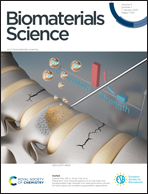A two-pronged strategy to alleviate tumor hypoxia and potentiate photodynamic therapy by mild hyperthermia†
Abstract
The application of photodynamic therapy (PDT) is limited by tumor hypoxia. To overcome hypoxia, catalase-like nanozymes are often used to catalyze endogenous H2O2 enriched in tumor tissues to O2. Nonetheless, the catalase activity may not be optimal at body temperature and the O2 supply may not meet the rapid O2 consumption of PDT. Herein, we provide a two-pronged strategy to alleviate tumor hypoxia based on hollow mesoporous Prussian blue nanoparticles (HMPB NPs). HMPB NPs can efficiently load the photosensitizer chlorin e6 (Ce6) and exhibit photothermal capability and temperature-dependent catalase activity. Under 808 nm laser irradiation, the photothermal effect of HMPB NPs elevated the catalase activity of HMPB NPs for O2 production. Furthermore, mild hyperthermia reduced cancer associated fibroblasts (CAFs) and induced extracellular matrix (ECM) degradation. The reduction of CAFs and the ECM decreased the solid stress of tumor tissues and normalized the tumor vasculature, which was beneficial for the external supplementation of O2 to tumors. Thereafter, under 606 nm laser irradiation, Ce6-mediated PDT generated excessive reactive oxygen species (ROS) that induced tumor cell apoptosis and achieved a high tumor inhibition rate of 92.2% in 4T1 breast tumors. Our work indicated that the alleviation of tumor hypoxia from both internal and external pathways significantly enhanced Ce6-mediated PDT against breast cancers.



 Please wait while we load your content...
Please wait while we load your content...